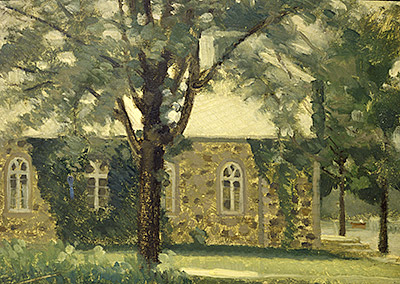In the House of Paul-Émile Borduas

The River of Time
Youth and Apprenticeship

Paul-Émile Borduas, Church of Saint-Hilaire, c. 1933,
oil on plywood. Collection of Renée Borduas.
Photo MBAM, Brian Merrett.
© Paul-Émile Borduas Estate / SODRAC (2013)
Borduas had his first real contact with art and painting in childhood, when his family attended religious services in the Saint-Hilaire church. From a very early age he could admire the work of Ozias Leduc in the decoration of this church. He later said that he was deeply affected by these special moments when he could abandon himself to contemplating these works of art.
Noticing that his son had a definite talent for drawing, Borduas’ father decided to present him to Ozias Leduc in 1922. Borduas began his true introduction into the world of art under this artist, who would become his mentor. Leduc taught him the basic principles of drawing, painting and church decoration. He soon recognized his pupil’s immense artistic talent and consequently proposed that Borduas work as his apprentice in Sherbrooke. During this period, Borduas continued his training in drawing and painting. Ozias Leduc also took the time to give him lessons in art history.
In the fall of 1923, enriched by this formative experience and with the encouragement of his master, Borduas enrolled at the École de Beaux-arts de Montréal (fine arts school). Despite feeling a certain incompatibility and dissatisfaction with the school’s teachings and academic approach, Borduas did well in his studies and obtained a teaching certificate. He soon found work as a part-time teacher in two Montréal elementary schools. His teaching methods, based on non-authoritative pedagogy and respect for individuality, won favour with both his pupils and the school authorities. This first contact with children and their spontaneous, free expression of emotions was a valuable experience for him. Nevertheless, Borduas resigned the following year, having lost a teaching position when he became the victim of bureaucratic power struggles. This reversal left him very bitter. Shortly afterwards, with the support of Ozias Leduc, Borduas received a study grant to advance his training at the Ateliers d’art sacré, a religious art school in Paris.
Header image: View of Saint-Hilaire at the turn of the XXth century. Malo-Plamondon collection.
Paul-Émile Borduas writes about Ozias Leduc: «But I already was familiar with his painting because of the little church at Saint-Hilaire, which he had generously decorated and which now is in danger of being ruined by clumsy repair work. From my birth to the age of fifteen or so, these were the sole paintings I ever had the privilege to see. You wouldn’t believe how proud I am that I had this single source of pictorial poetry at a time when the slightest impressions penetrate our inner depths and, without our knowing it, shape the foundations of our critical judgement. How could one later betray these directives that come from one no longer knows where and that, in all honesty, one might well attribute to providence? It will be strange for some people to hear that I have remained faithful to the essential of these first impressions. I am convinced that, subsequently, admiration for any painting had to be in accord with them – believe it or not.»
© Musée des beaux-arts de Mont-Saint-Hilaire, 2014.
All rights reserved.

